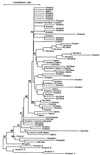A single and early migration for the peopling of the Americas supported by mitochondrial DNA sequence data
- PMID: 9050871
- PMCID: PMC20009
- DOI: 10.1073/pnas.94.5.1866
A single and early migration for the peopling of the Americas supported by mitochondrial DNA sequence data
Abstract
To evaluate the number and time of the migration(s) that colonized the New World we analyzed all available sequences of the first hypervariable segment of the human mitochondrial DNA control region, including 544 Native Americans. Sequence and population trees showed that the Amerind, Na-Dene, and Eskimo are significantly closer among themselves than anyone is to Asian populations, with the exception of the Siberian Chukchi, that in some analyses are closer to Na-Dene and Eskimo. Nucleotide diversity analyses based on haplogroup A sequences suggest that Native Americans and Chukchi originated from a single migration to Beringia, probably from east Central Asia, that occurred approximately 30,000 or approximately 43,000 years ago, depending on which substitution rate is used, with 95% confidence intervals between approximately 22,000 and approximately 55,000 years ago. These results support a model for the peopling of the Americas in which Beringia played a central role, where the population that originated the Native Americans settled and expanded. Some time after the colonization of Beringia they crossed the Alberta ice-free corridor and peopled the rest of the American continent. The collapse of this ice-free corridor during a few thousand years 14,000-20,000 years ago isolated the people south of the ice-sheets, who gave rise to the Amerind, from those still in Beringia; the latter originated the Na-Dene, Eskimo, and probably the Siberian Chukchi.
Figures



Similar articles
-
Mitochondrial DNA and Y chromosome diversity and the peopling of the Americas: evolutionary and demographic evidence.Am J Hum Biol. 2004 Jul-Aug;16(4):420-39. doi: 10.1002/ajhb.20041. Am J Hum Biol. 2004. PMID: 15214060
-
Mitochondrial genome diversity in arctic Siberians, with particular reference to the evolutionary history of Beringia and Pleistocenic peopling of the Americas.Am J Hum Genet. 2008 May;82(5):1084-100. doi: 10.1016/j.ajhg.2008.03.019. Epub 2008 May 1. Am J Hum Genet. 2008. PMID: 18452887 Free PMC article.
-
The dual origin and Siberian affinities of Native American Y chromosomes.Am J Hum Genet. 2002 Jan;70(1):192-206. doi: 10.1086/338457. Epub 2001 Nov 30. Am J Hum Genet. 2002. PMID: 11731934 Free PMC article.
-
The late Pleistocene dispersal of modern humans in the Americas.Science. 2008 Mar 14;319(5869):1497-502. doi: 10.1126/science.1153569. Science. 2008. PMID: 18339930 Review.
-
The initial peopling of the Americas: an overview from the perspective of physical anthropology.Acta Anthropogenet. 1984;8(1-2):1-21. Acta Anthropogenet. 1984. PMID: 6443184 Review.
Cited by
-
Environmental conditions associated with initial northern expansion of anatomically modern humans.Nat Commun. 2024 May 22;15(1):4364. doi: 10.1038/s41467-024-48762-8. Nat Commun. 2024. PMID: 38777837 Free PMC article.
-
Beringia and the peopling of the Western Hemisphere.Proc Biol Sci. 2023 Jan 11;290(1990):20222246. doi: 10.1098/rspb.2022.2246. Epub 2023 Jan 11. Proc Biol Sci. 2023. PMID: 36629115 Free PMC article. Review.
-
Novel alleles gained during the Beringian isolation period.Sci Rep. 2022 Mar 11;12(1):4289. doi: 10.1038/s41598-022-08212-1. Sci Rep. 2022. PMID: 35277570 Free PMC article.
-
Uniparental markers reveal new insights on subcontinental ancestry and sex-biased admixture in Brazil.Mol Genet Genomics. 2022 Mar;297(2):419-435. doi: 10.1007/s00438-022-01857-7. Epub 2022 Jan 21. Mol Genet Genomics. 2022. PMID: 35061071
-
Analysis of human mitochondrial DNA sequences from fecally polluted environmental waters as a tool to study population diversity.AIMS Environ Sci. 2017;4(3):443-455. doi: 10.3934/environsci.2017.3.443. AIMS Environ Sci. 2017. PMID: 32802939 Free PMC article.
References
-
- Hoffecker J F, Powers W R, Goebel T. Science. 1993;259:532–536. - PubMed
-
- Cavalli-Sforza L L, Piazza A, Menozzi P. History and Geography of Human Genes. Princeton: Princeton Univ. Press; 1994.
-
- Cann R L, Lum J K. Am J Hum Genet. 1996;59:256–258.
-
- Greenberg J H, Turner C G, Zegura S L. Curr Anthropol. 1986;27:477–498.
Publication types
MeSH terms
Substances
LinkOut - more resources
Full Text Sources


